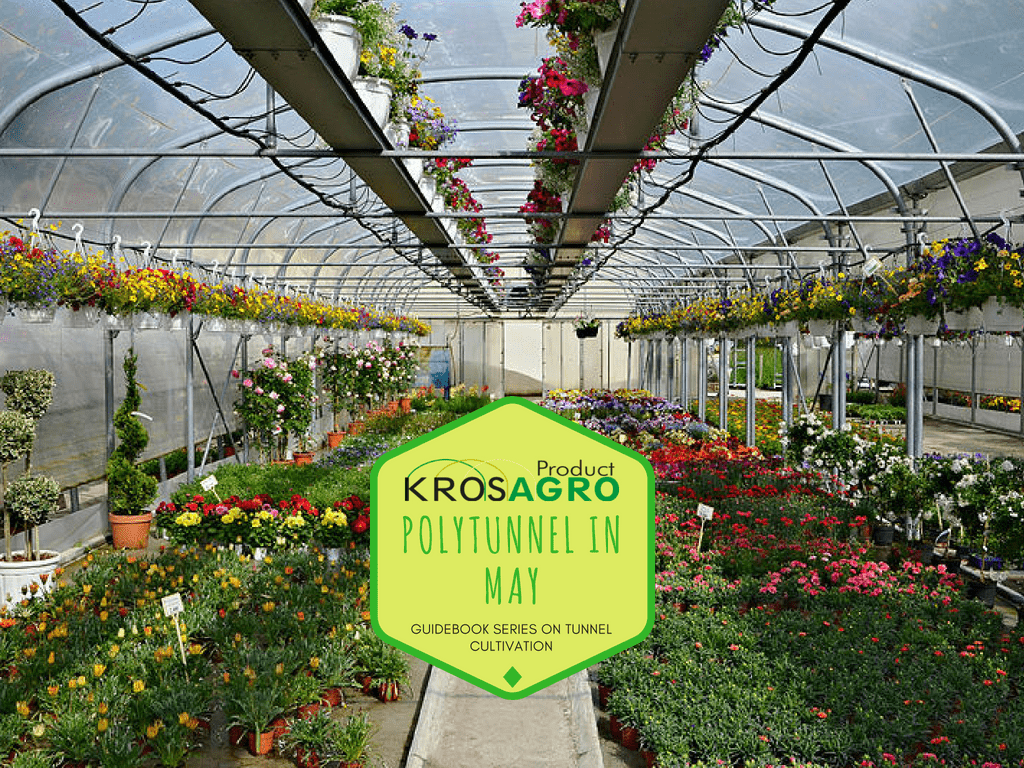Spring is always a busy time on the plot. May in a polytunnel often means that the first harvests (spring vegetables) have already peaked in the garden. This time in this Krosagro guide, we will tell you how to take care of crops and greenhouse in May, step by step.
Contents
Crops under cover in May
1. Take care of plants in the polytunnel
In May, the crop begins to grow dynamically, so it will be very important to systematically look after all aspects of cultivation. Making sure vegetables and fruits can thrive in a comfortable environment. As long as mistakes are avoided at the stage of planting and introducing seedlings. The plants will have enough space to grow. Otherwise, those developing too much may hamper the slower maturing ones. To prevent this, if possible, try to restrict some of them, cut them, and in the worst case remove them.
2. Keep pests under control
Heat and a larger amount of light have a positiveeffect on plants, but not only. May sees the breeding of many pests, which quickly multiply when food is available. As soon as pest is noticed on crops, it must be identified , then eliminated using appropriate methods. Although foil makes it difficult for insects to enter the facility , it is worth preventing their invasion, closely monitoring the plants. Taking safety precautions will save the gardener more trouble.
3. Ventilate the greenhouse
In May, there are significant temperature differences between day and night. This can lead to an increase in humidity concentration inside the cover. Therefore, to avoid this, it is necessary to ventilate. Similarly, if the temperature is too high in the greenhouse, removing the excess heat outside the structure is also required. Side vents contribute to control the microclimate in a gardening tunnel. Polytunnels with ventilation on both sides are equipped with openings, which create an air flow when lifted. That way, excess moisture, heat and stale air can be removed. This creates favorable conditions for crop growth. It improves work conditions, making care duties more pleasant than in a overheated foil tunnel. It is worth mentioning that an insect net is provided with such vents, further protecting plants against unwanted guests.
4. Use all available cultivating sites on garden beds and gardening boxes
Following harvest of crops and after digging and feeding the soil, it is time to fill the space with new plants. With previously planned crop rotation, you can start sowing or transfering seedlings after maintenance work. However, with spontaneous planting, it is worth finding out which plants are best suited to take over the spot. When planting the same species, the chance of appearance of harmful fungi in the soil or pests increases significantly.
What to plant, grow and harvest in a polytunnel in May?
Sowing of summer thermophilic plants / introduction of seedlings:
Eggplant: Seeds germinate quickly at temperatures between 20 to 30°. Do not plant eggplant transplants into the garden until after the last threat of frost.
Pepper: high humidity and warm climate required. Thrives best on virgin soils rich in humus
Chili: dry weather is suitable for fruit maturity. Range between 20⁰-25⁰C is ideal temperature range for chilli growth
Tomatoes: long-growing, heat-seeking, sun lovers. These warm-season plants do not tolerate frost
Basil: Soil should be moist but well-drained. Basil works great in containers or raised beds
Courgette: easy to grow from seed. They are best started off indoors in pots, but you can also sow them outdoors in the spot where they are to grow.
Cucumbers: easy to cultivate vegetable that loves sun and water, cucumbers grow quickly as long as they receive consistent watering and warmth
Seedlings prepared earlier:
Green Beans: do not to plant the seeds too early. Plant after all danger of frost has passed. Seeds sown too early may rot in cold, damp soil, and the plants need warm weather to thrive.
Celery : low tolerance for heat and prefers a cool, cloudy location where growing temperatures range between 15° and 20°
Shallot: can be sown from seed, but most gardeners prefer to start from sets as they are quicker to mature
Dill: sow your seeds 2-3 weeks before your last spring frost, prepare the soil well, choosing a fertile, open site in full sun, water daily until seedlings emerge
Coriander: sown from late March until early September, grow best sown directly rather than grown in seed trays, add good garden compost
Conclusion
As positive temperatures are now a regular feature outside, favorable conditions prevail inside the greenhouse. After preparing, feeding the ground and reorganizing the greenhouse in gardening boxes, you can sow new seeds or introduce seedlings. The polytunnel in May should nonetheless be systematically ventilated in May, as well as providing water and quickly reacting when pathogens or pests appear. While enjoying this year’s new vegetables, remember to take care of the main crop.
